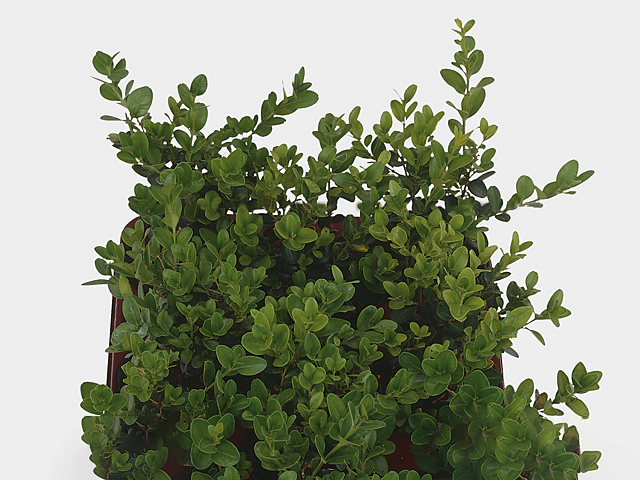Buxus microphylla 'Faulkner'

| Leaf margin | Entire |
| Leaf type | Foliage leaf |
| Winter hardness | Good (USDA-zone 5, 6) |
| Inflorescence | Raceme |
| Structure (tissues) | Woody |
| soil pH requirement | Neutral (pH 6,5 - 7,5) |
| Light conditions | Semi-shades |
| Leaf division | Simple |
| Plant, growth type | Erect |
| Leaf colour, pattern | Marginate |
| Toxicity (if consumed) | Highly toxic |
| Moisture requirements | Well-drained |
Buxus microphylla 'Faulkner', more commonly known as Boxwood, is a popular evergreen shrub with a variety of desirable qualities. This particular cultivar of Boxwood has a number of unique characteristics that make it a favorite among gardeners.
One notable trait of Buxus microphylla 'Faulkner' is its leaf margin, which is entire. This means that the edges of the leaves are smooth and without any teeth or serrations. This adds to the plant's clean and polished appearance.
The leaves themselves are foliage leaves, which means they are primarily grown for their attractive appearance rather than for their ability to photosynthesize. This makes Buxus microphylla 'Faulkner' a great choice for adding texture and greenery to any garden.
In terms of winter hardiness, Buxus microphylla 'Faulkner' is considered to be good. It is well-suited for USDA zones 5 and 6, meaning it can withstand cold temperatures and still thrive. This makes it a reliable choice for gardeners in colder regions who want to add some evergreen beauty to their landscape.
When it comes to inflorescence, Buxus microphylla 'Faulkner' produces racemes of flowers. A raceme is a type of flower cluster in which each flower is attached to the same stem, creating a distinctive and elegant look. These flowers can add a touch of color to the otherwise green foliage of the plant.
In terms of structure, Buxus microphylla 'Faulkner' has woody tissues. This means that it has a solid and durable structure that can withstand the test of time. This makes it a long-lasting and reliable addition to any garden.
When it comes to soil pH requirements, Buxus microphylla 'Faulkner' prefers a neutral pH level of around 6.5 to 7.5. This is considered to be a relatively easy pH level to achieve and maintain, making it suitable for a wide range of gardeners.
In terms of light conditions, Buxus microphylla 'Faulkner' thrives in semi-shade. This means that it prefers to be in an area where it receives some direct sunlight, but also enjoys some shade throughout the day. This makes it a versatile plant that can be grown in different areas of a garden.
The leaf division of Buxus microphylla 'Faulkner' is simple, meaning that each leaf is undivided and not subdivided into smaller leaflets. This contributes to the plant's overall aesthetic appeal and adds to its clean and sleek appearance.
The leaf color and pattern of Buxus microphylla 'Faulkner' is marginate, meaning that the leaves have distinct contrasting margins. This creates a visually striking effect and adds interest to the plant's foliage.
It is important to note that Buxus microphylla 'Faulkner' is highly toxic if consumed. This means that caution should be exercised if there are pets or small children around the plant.
Lastly, Buxus microphylla 'Faulkner' requires well-drained soil and prefers to be planted in an area with good drainage. This ensures that the roots do not sit in water, which can lead to root rot and other issues.
Overall, Buxus microphylla 'Faulkner' is a beautiful and reliable addition to any garden. Its unique qualities, from its entire leaf margin to its woody structure, make it a highly desirable plant for both experienced and novice gardeners.
Market availability index by month:
| Jan. | Feb. | Mar. | Apr. | May | Jun. | Jul. | Aug. | Sep. | Oct. | Nov. | Dec. |
|---|---|---|---|---|---|---|---|---|---|---|---|
| 1 | 3 | 3 | 4 | 2 | 2 | 1 | 1 | 4 | 3 | 1 | 1 |